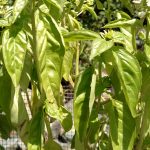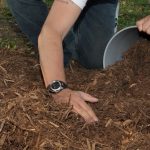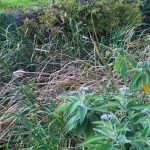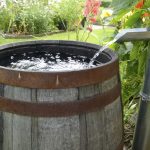by Ken Lain, the mountain gardener
 Stressed plants, resultant from inadequate amounts of rain or irrigation, cause a multitude of gardening issues. Usually, the oldest leaves are the first to show symptoms of stress by yellowing, drying, and falling off the plant. During prolonged periods of drought, the twigs and branches of trees and shrubs suffer dieback. There can even be root damage from drought, which leads to the eventual death of the plant.
Stressed plants, resultant from inadequate amounts of rain or irrigation, cause a multitude of gardening issues. Usually, the oldest leaves are the first to show symptoms of stress by yellowing, drying, and falling off the plant. During prolonged periods of drought, the twigs and branches of trees and shrubs suffer dieback. There can even be root damage from drought, which leads to the eventual death of the plant.
The longer our drought, the more damage is done. Drought during the spring growing season causes the most damage when plants are actively growing and preparing themselves for the summer.
During prolonged droughts, all we can do is wait, and hope our drip irrigation is wet enough to keep plants alive. Plants have a better chance of surviving drought if they were healthy, vigorous, and mulched before the drought. Once the drought is over, it’s time to assess the damage and take steps to get plants back into shape.
1. Don’t Over Water – We want to increase the irrigation, but too much of even a good thing can be bad, especially in our gardens. Established plants need a deep soak once per week during the  growing season, then they need to breathe. Any more than that and you risk damaging tender new root hairs trying to grow into the surrounding soils. The objective is to ease plants back into health. Keep the ground moist, but not wet. Roots need oxygen even more than water and keeping the soil saturated suffocates tender new root growth that leads to even more stress, even death. There’s not much we can do about too much rain, but we can control irrigation systems, hoses, and sprinklers.
growing season, then they need to breathe. Any more than that and you risk damaging tender new root hairs trying to grow into the surrounding soils. The objective is to ease plants back into health. Keep the ground moist, but not wet. Roots need oxygen even more than water and keeping the soil saturated suffocates tender new root growth that leads to even more stress, even death. There’s not much we can do about too much rain, but we can control irrigation systems, hoses, and sprinklers.
Most plants need 1 inch of water per week or about 1 gallon per square foot of garden space per week. They may need more if they are growing in sandy, quick-draining soil, or recently planted with undeveloped roots. Increase water cycles to twice per week, to make sure they are taking up sufficient water.
Tomato Growers – Two common disorders of tomatoes are caused by receiving irregular amounts of water. Cracking and blossom end rot is caused by the plants being left dry, followed by excessive watering.
2. Prune Judiciously – During long droughts it sometimes helps to prune back otherwise  healthy plants by about 1/3, thereby lessening the plants’ foliage mass, and thus their need for water. Use your best judgment. But remember their canopies prevent scorching and burning, and pruning them too far back could invite additional stress.
healthy plants by about 1/3, thereby lessening the plants’ foliage mass, and thus their need for water. Use your best judgment. But remember their canopies prevent scorching and burning, and pruning them too far back could invite additional stress.
When the drought has ended, if the tops of plants have suffered severe browning and dieback, go ahead and prune back to about 6 inches from the ground. In many cases, you will see new growth already starting at the base of the plant; plants just know when they are threatened and need to reinvigorate.
Remove any dead or dying branches. They won’t recover, and they make preferred hiding places for pests and entry points for disease.
3. Fertilize with Discretion – Don’t fertilize with chemical- or petroleum-based plant foods during drought. Without adequate water, these fertilizers will be wasted or just cause more stress. Nationally branded synthetic plant foods contain salt; they are the worst possible options following a drought. I avoid them entirely. The salt in the soil, magnified by salt-based fertilizers like Miracle Gro, damages plant roots and intensifies drought damage.
Best to use a slow release organic plant food like Watters 7-4-4 All Purpose Purpose Plant Food to help ease plants back to vigor.
4. Scout for Secondary Problems – Drought-stressed plants are targets for pests and diseases, which will weaken stressed plants even more. While we should be on the lookout for problems throughout the season, keep an especially keen eye out during drought. It always is best to catch problems early. In some cases, you may need to do some pruning or even remove the plant entirely.
5. Replenish Mulch – Once your plants have been well watered and fed, make sure they have a 3-4 inch layer of organic mulch around their drip lines. Organic mulches decompose during the growing season, and by mid-summer, they virtually have vanished. Keep stressed roots cool and moist by replacing the mulch as soon as its disappearance is noticed.
6. Replace plants with plants that are more drought tolerant – Some plants handle drought better than others. Choose drought-tolerant plants that create a more xeric garden with lower water needs. If you must have plants with high water needs, group them together so as to water heavily only in their exact area.
7. Add more Organic Matter – Continually add compost and other organic matter to your soil.  It will improve a soil’s ability to retain moisture.
It will improve a soil’s ability to retain moisture.
8. Weeds are BAD! – Weeds compete with garden plants for water and nutrients, and weeds usually win! Take steps to prevent weeds.
9. Rain Barrels – Now is the time to attach a rain barrel (or two, or  three) to your downspout. It’s incredible how much water can be collected after just one rain and how glad you’ll be to have it during the next dry spell.
three) to your downspout. It’s incredible how much water can be collected after just one rain and how glad you’ll be to have it during the next dry spell.
Take a picture of stressed plants and bring your iPad to the next gardening class. We often discuss stressed-out trees and how to bring the gardens back into the color and vibrance expected of them.
Next free gardening class at the garden center:
August 11 @ 9:30 am ‘Herbs from Garden to Table’ – Summer is the ideal time to add herbs to our gardens. Special guest instructor Deborah Maranville, chef, and owner of Natural Healing Garden, knows her herbs and uses them to create health-centered foods that focus on utilizing local produce and delicious organic food. Join Deborah for a tantalizing cooking demonstration that will focus on the best techniques to get the herbs from your garden to spice up your cooking.
Until next week, I’ll be here at Watters Garden Center helping local gardeners to grow REALLY BIG flowers.
Ken Lain can be found throughout the week at Watters Garden Center, 1815 W. Iron Springs Rd in Prescott, or contacted through his website at WattersGardenCenter.com or FB.com/WattersGardenCenter

